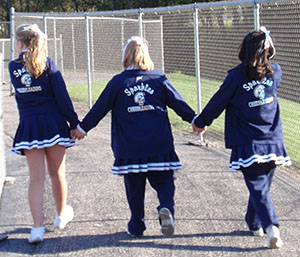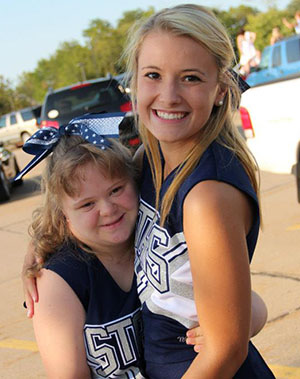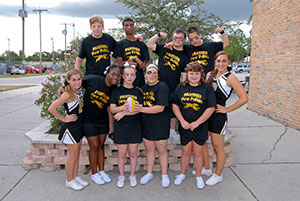How do we make schools more inclusive for children with disabilities?

Learning how to fit in with peers, handling new responsibilities and balancing homework with after-school activities are familiar challenges for many students in high school.
Students with a disability face an entirely different challenge: most school-based social and educational opportunities are tailored for able-bodied children. This means that students with disabilities have far fewer opportunities to interact with other children, and fewer opportunities to learn from those social interactions.
“So many children with disabilities are not celebrated for their capabilities and are hidden away from the world because of fear and ignorance,” said 2013 Honoree Chaeli Mycroft in UNICEF’s The State of the World’s Children 2013. “We need to realize that people with disabilities are crucial in our population. People with disabilities are often the ones who think outside the box – because we have to.”
What are some ways that schools can start including children with disabilities?
We asked 2013 Honoree Sarah Cronk how to make high schools more inclusive for children with disabilities. In 2008, Sarah founded the United States’ very first cheerleading team that included children with disabilities. Today, she runs The Sparkle Effect, a nonprofit that has established more than 100 inclusive cheerleading and dance teams in middle schools, high schools and colleges across the United States. (We recently featured The Sparkle Effect’s 100th team started at Mercer Island High School.)
What would you say is the number one need for students with disabilities in the United States?

Over 5 million students with disabilities attend public schools in the United States; yet most school sports and activities are not designed to accommodate these students. Not surprisingly, then, students with disabilities are too often sidelined–excluded from high school sports and the critical social opportunities they offer. For young people, socializing with peers is a huge part of what school is about. Without it, students’ self-esteem and confidence suffer. Those feelings of isolation and loneliness negatively impact quality of life.
I believe that it is unjust to deny students with disabilities the opportunity to participate and belong to a team, especially given that accommodating their needs is relatively easy. It is also unjust to perpetuate the segregation of students with disabilities from their typically-developing peers, as that segregation denies both groups the opportunity to grow and learn together.
The U.S. Secretary of Education, Arne Duncan, in advocating for the inclusion of students with disabilities on sports teams, recently stated: “Playing sports at any level . . . can be a key part of the school experience and have an immense and lasting impact on a student’s life. . . . [P]articipation in extracurricular athletic activities promotes socialization, the development of leadership skills, focus, and, of course, physical fitness.” I couldn’t agree more. However, while the majority of America’s students have myriad opportunities to participate in recreation, after-school activities, and sports, these opportunities are limited for students with disabilities.
What are some of the challenges you face when creating inclusive dance and cheerleading teams?

The number one challenge in creating inclusive sports teams in high schools is the lack of school funding for new programming. Before I created The Sparkle Effect’s uniform grant program and free on-site training, I was hearing from cheerleaders nationwide that lack of funding was hampering their ability to generate inclusive teams. I set my sights on securing funding so that I could tangibly support inclusive teams.
Another challenge we face is convincing people that fully integrated programming for students with disabilities is far more powerful than segregated programming. Cheerleading is very popular across the United States. Prior to the formation of The Sparkle Effect, virtually all of the cheerleading teams geared toward students with disabilities were affiliated with All-Star gyms, which are adult-led, segregated, pay-to-play models, operated completely outside of the high school community. These programs offer no opportunities for high school aged students with disabilities to cheer for and with their peers at school sporting events.
Finally, students in the United States operate in a very competitive culture. In the highly competitive world of high school sports, teens are taught to perfect their skills, to conquer, to win. The Sparkle Effect strives every day to teach people to value connection over perfection. In fact, The Sparkle Effect thoroughly enjoys turning on its head the stereotype of cheerleaders as self-involved elitists. Given the chance, Sparkle Effect teams instantly transform what was previously seen as the most exclusive group in high school into the most inclusive.
With all that you have accomplished, can you share one moment that has stuck with you?
My initial challenge in creating the first Sparkle Effect squad at my high school was convincing skeptical administrators to embrace a program that, at the time, was revolutionary. After much discussion, our administration gave us a hesitant green light, explaining that they would endorse a limited pilot program that would continue only if the student body responded appropriately at the first game.
The inclusive team began practicing in the high school cafeteria in the summer of 2008. We established friendship and trust with one another and, in the sheltered environment of the cafeteria, we all felt safe and comfortable. However, I worried about how our team would fare at that first football game of the season – our first game as an inclusive team. I knew it would be loud and chaotic and I worried about how the students might react during the our debut. Our “front line” of seniors is known for being particularly rowdy, and I was concerned about how they would respond to our new group.
As it turned out, my fears were completely unfounded. As our new team took the field at that first game of the season, the entire student section—even the senior boys with their spiked Mohawks and painted chests —stood up and began chanting, “Let’s go Sparkles, let’s go!” When we finished performing, every person in our stadium rose to their feet and began to cheer. There wasn’t a dry eye in the house. At that moment, I realized that this unprecedented and unlikely squad was going to change the culture of my high school forever.

Help support programs like The Sparkle Effect. A gift of $100 is enough to buy a new cheerleading uniform for a disabled child on a Sparkle Effect team. 100% of your gift directly supports programs serving children in need.